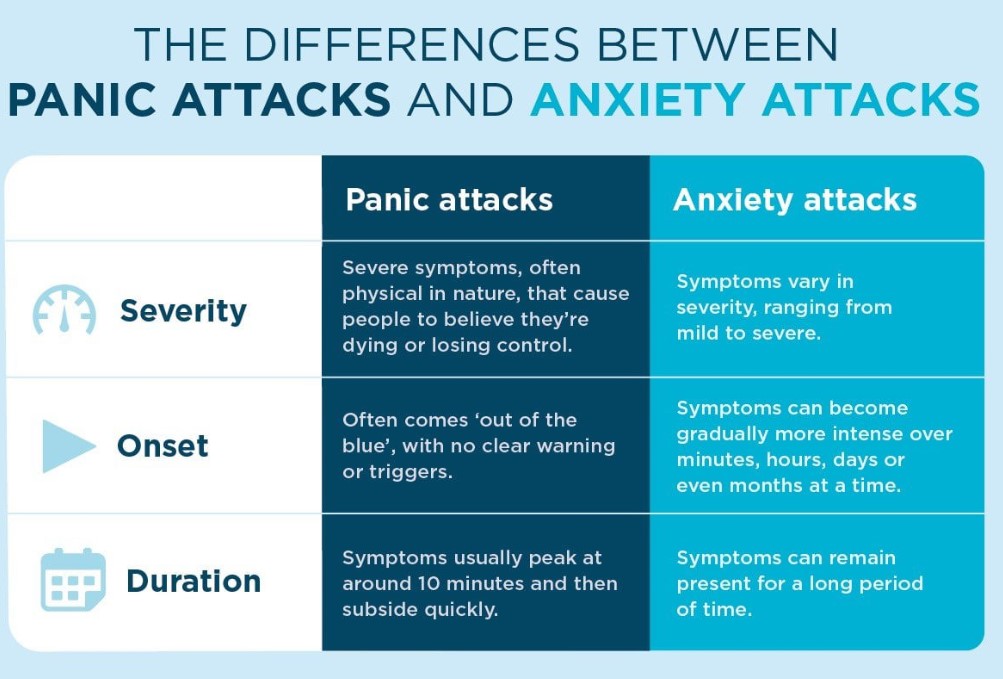BOURSESSENEGAL – When it comes to mental health, distinguishing between a panic attack vs anxiety attack is crucial. Both conditions can cause intense feelings of fear and distress, but they manifest in different ways. Understanding these differences can help you or a loved one manage symptoms more effectively and seek appropriate treatment.
What is a Panic Attack?
A panic attack is an abrupt surge of intense fear or discomfort that peaks within minutes. During a panic attack, individuals often experience overwhelming physical symptoms. These can include:
- Rapid heart rate
- Shortness of breath
- Chest pain
- Sweating
- Trembling or shaking
- Dizziness or lightheadedness
- Nausea
- Feelings of unreality or detachment
Symptoms of Panic Attacks
Panic attacks can occur unexpectedly, even when you’re relaxed or asleep. They often feel like you’re losing control or even having a heart attack. This intensity can be frightening and may lead to changes in behavior. Many individuals start avoiding situations where they previously experienced panic attacks.
Duration and Frequency
Typically, a panic attack lasts around 10 to 30 minutes, though some symptoms may linger longer. The unpredictable nature of these attacks can lead to significant anxiety about experiencing another one, contributing to a cycle of panic.
What is an Anxiety Attack?
In contrast, an anxiety attack isn’t officially recognized in medical literature but is often used to describe heightened anxiety that is triggered by a specific stressor. It usually develops gradually and is associated with ongoing stress or worry.
Symptoms of Anxiety Attacks
While the symptoms of an anxiety attack can overlap with those of a panic attack, they are usually less intense. Common symptoms include:
- Excessive worrying
- Restlessness
- Fatigue
- Difficulty concentrating
- Irritability
- Muscle tension
Duration and Triggers
Anxiety attacks can last for extended periods, often hours or even days. Triggers can be specific, such as a stressful work deadline or relationship issues, and may build over time. This gradual onset can make it difficult for individuals to recognize when anxiety becomes overwhelming.
Key Differences Between Panic and Anxiety Attacks
Understanding the distinctions between panic attack vs anxiety attack is essential for effective management. Here are some of the critical differences:
Onset
- Panic Attack: Sudden and unexpected.
- Anxiety Attack: Gradual and often linked to specific stressors.
Duration
- Panic Attack: Typically short-lived, lasting a few minutes to half an hour.
- Anxiety Attack: Can persist for hours or days.
Physical Symptoms
- Panic Attack: Intense physical symptoms that may mimic heart problems.
- Anxiety Attack: Symptoms are usually milder and more psychological in nature.
Emotional Experience
- Panic Attack: Often accompanied by a sense of impending doom or fear of losing control.
- Anxiety Attack: More related to persistent worry and stress.
How to Cope with Panic and Anxiety Attacks
Recognizing the symptoms is the first step toward managing both panic and anxiety attacks. Here are some strategies to cope effectively:
For Panic Attacks
- Breathing Exercises: Deep, slow breathing can help reduce the feeling of panic. Focus on inhaling deeply through your nose, holding for a moment, and exhaling slowly through your mouth.
- Grounding Techniques: Grounding exercises, like focusing on your surroundings, can help distract you from panic symptoms.
- Seek Support: Talking to someone you trust can provide comfort and reassurance during an attack.
For Anxiety Attacks
- Identify Triggers: Keep a journal to note situations that cause anxiety. Understanding your triggers can help you prepare and cope more effectively.
- Practice Mindfulness: Mindfulness and meditation techniques can help manage anxiety levels by promoting relaxation and focus.
- Physical Activity: Regular exercise releases endorphins, which can alleviate feelings of anxiety.
When to Seek Professional Help
Both panic and anxiety attacks can significantly affect daily life. If you or someone you know experiences frequent or debilitating attacks, seeking professional help is crucial. A mental health professional can provide a comprehensive evaluation and recommend appropriate treatment options. This may include:
- Cognitive Behavioral Therapy (CBT)
- Medication
- Stress management techniques
Conclusion
In summary, understanding the differences between panic attack vs anxiety attack is essential for effective management. Panic attacks are sudden and intense, while anxiety attacks build gradually and are usually linked to stressors. By recognizing symptoms and implementing coping strategies, you can take proactive steps toward managing both conditions. Remember, seeking professional help can provide the support and resources necessary for your mental health journey. Don’t hesitate to reach out for help—you’re not alone in this.
By understanding these concepts, you empower yourself or a loved one to navigate the complexities of mental health with greater confidence and clarity.
REFERENCE : https://en.wikipedia.org/



